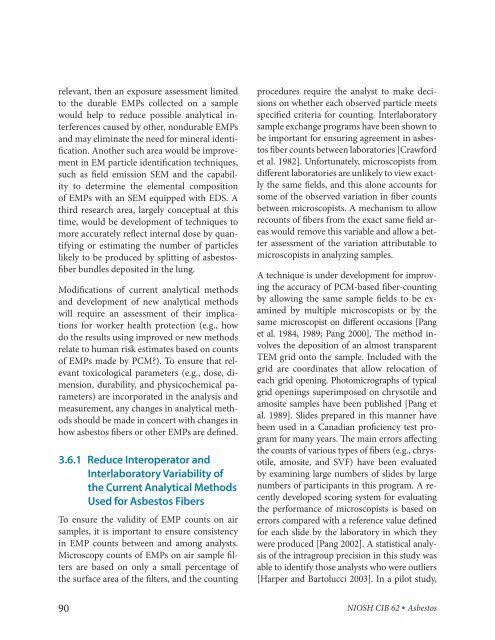Asbestos Fibers and Other Elongate Mineral Particles: State of the ...
Asbestos Fibers and Other Elongate Mineral Particles: State of the ...
Asbestos Fibers and Other Elongate Mineral Particles: State of the ...
- No tags were found...
You also want an ePaper? Increase the reach of your titles
YUMPU automatically turns print PDFs into web optimized ePapers that Google loves.
elevant, <strong>the</strong>n an exposure assessment limited<br />
to <strong>the</strong> durable EMPs collected on a sample<br />
would help to reduce possible analytical interferences<br />
caused by o<strong>the</strong>r, nondurable EMPs<br />
<strong>and</strong> may eliminate <strong>the</strong> need for mineral identification.<br />
Ano<strong>the</strong>r such area would be improvement<br />
in EM particle identification techniques,<br />
such as field emission SEM <strong>and</strong> <strong>the</strong> capability<br />
to determine <strong>the</strong> elemental composition<br />
<strong>of</strong> EMPs with an SEM equipped with EDS. A<br />
third research area, largely conceptual at this<br />
time, would be development <strong>of</strong> techniques to<br />
more accurately reflect internal dose by quantifying<br />
or estimating <strong>the</strong> number <strong>of</strong> particles<br />
likely to be produced by splitting <strong>of</strong> asbestosfiber<br />
bundles deposited in <strong>the</strong> lung.<br />
Modifications <strong>of</strong> current analytical methods<br />
<strong>and</strong> development <strong>of</strong> new analytical methods<br />
will require an assessment <strong>of</strong> <strong>the</strong>ir implications<br />
for worker health protection (e.g., how<br />
do <strong>the</strong> results using improved or new methods<br />
relate to human risk estimates based on counts<br />
<strong>of</strong> EMPs made by PCM?). To ensure that relevant<br />
toxicological parameters (e.g., dose, dimension,<br />
durability, <strong>and</strong> physicochemical parameters)<br />
are incorporated in <strong>the</strong> analysis <strong>and</strong><br />
measurement, any changes in analytical methods<br />
should be made in concert with changes in<br />
how asbestos fibers or o<strong>the</strong>r EMPs are defined.<br />
3.6.1 Reduce Interoperator <strong>and</strong><br />
Interlaboratory Variability <strong>of</strong><br />
<strong>the</strong> Current Analytical Methods<br />
Used for <strong>Asbestos</strong> <strong>Fibers</strong><br />
To ensure <strong>the</strong> validity <strong>of</strong> EMP counts on air<br />
samples, it is important to ensure consistency<br />
in EMP counts between <strong>and</strong> among analysts.<br />
Microscopy counts <strong>of</strong> EMPs on air sample filters<br />
are based on only a small percentage <strong>of</strong><br />
<strong>the</strong> surface area <strong>of</strong> <strong>the</strong> filters, <strong>and</strong> <strong>the</strong> counting<br />
90<br />
procedures require <strong>the</strong> analyst to make decisions<br />
on whe<strong>the</strong>r each observed particle meets<br />
specified criteria for counting. Interlaboratory<br />
sample exchange programs have been shown to<br />
be important for ensuring agreement in asbestos<br />
fiber counts between laboratories [Crawford<br />
et al. 1982]. Unfortunately, microscopists from<br />
different laboratories are unlikely to view exactly<br />
<strong>the</strong> same fields, <strong>and</strong> this alone accounts for<br />
some <strong>of</strong> <strong>the</strong> observed variation in fiber counts<br />
between microscopists. A mechanism to allow<br />
recounts <strong>of</strong> fibers from <strong>the</strong> exact same field areas<br />
would remove this variable <strong>and</strong> allow a better<br />
assessment <strong>of</strong> <strong>the</strong> variation attributable to<br />
microscopists in analyzing samples.<br />
A technique is under development for improving<br />
<strong>the</strong> accuracy <strong>of</strong> PCM-based fiber-counting<br />
by allowing <strong>the</strong> same sample fields to be examined<br />
by multiple microscopists or by <strong>the</strong><br />
same microscopist on different occasions [Pang<br />
et al. 1984, 1989; Pang 2000]. The method involves<br />
<strong>the</strong> deposition <strong>of</strong> an almost transparent<br />
TEM grid onto <strong>the</strong> sample. Included with <strong>the</strong><br />
grid are coordinates that allow relocation <strong>of</strong><br />
each grid opening. Photomicrographs <strong>of</strong> typical<br />
grid openings superimposed on chrysotile <strong>and</strong><br />
amosite samples have been published [Pang et<br />
al. 1989]. Slides prepared in this manner have<br />
been used in a Canadian pr<strong>of</strong>iciency test program<br />
for many years. The main errors affecting<br />
<strong>the</strong> counts <strong>of</strong> various types <strong>of</strong> fibers (e.g., chrysotile,<br />
amosite, <strong>and</strong> SVF) have been evaluated<br />
by examining large numbers <strong>of</strong> slides by large<br />
numbers <strong>of</strong> participants in this program. A recently<br />
developed scoring system for evaluating<br />
<strong>the</strong> performance <strong>of</strong> microscopists is based on<br />
errors compared with a reference value defined<br />
for each slide by <strong>the</strong> laboratory in which <strong>the</strong>y<br />
were produced [Pang 2002]. A statistical analysis<br />
<strong>of</strong> <strong>the</strong> intragroup precision in this study was<br />
able to identify those analysts who were outliers<br />
[Harper <strong>and</strong> Bartolucci 2003]. In a pilot study,<br />
NIOSH CIB 62 • <strong>Asbestos</strong>

















